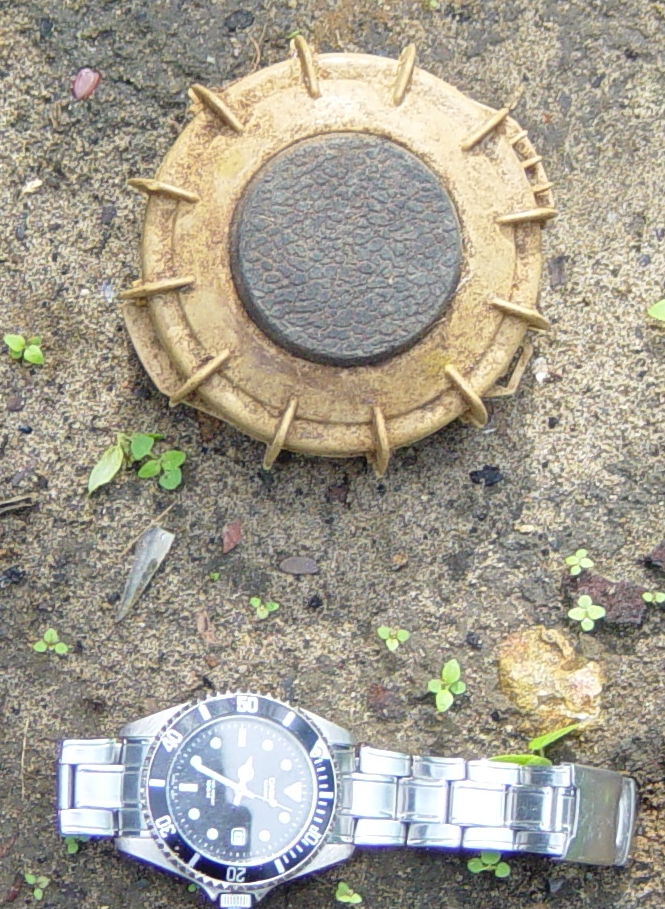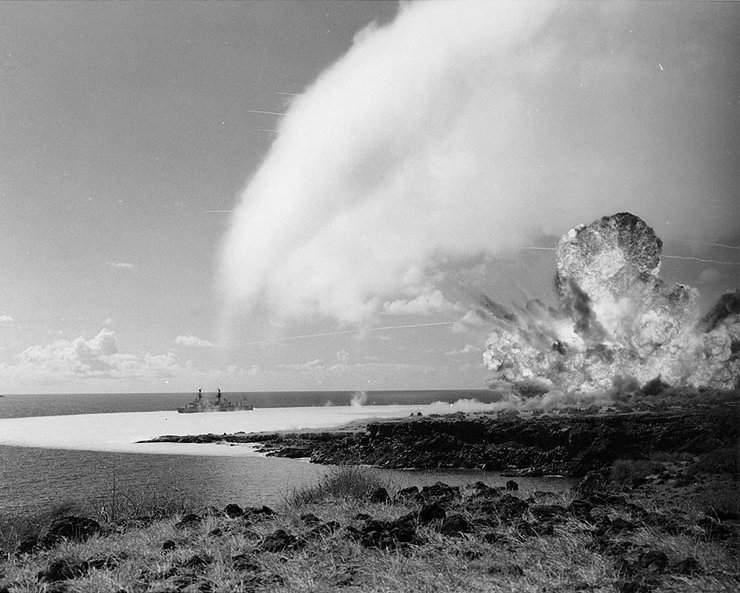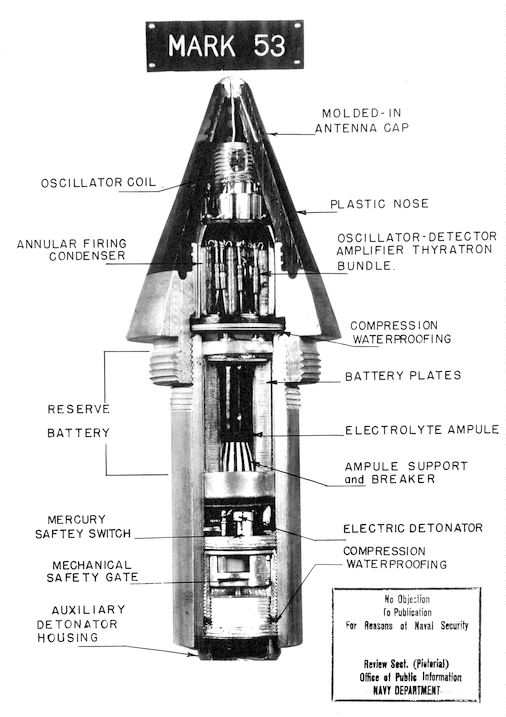|
M19 Mine
The M19 is a large square plastic cased United States anti-tank blast mine. Intended to replace the M15 mine, the design dates from the mid-1960s and contains only two metal components: the copper detonator capsule and a stainless steel firing pin which weighs 2.86 grams. It is a minimum metal mine, which makes it very difficult to detect after it has been emplaced. This mine is produced under licence in Chile, South Korea and Turkey. A copy is produced in Iran. It is found in Afghanistan, Angola, Chad, Chile, Cyprus, Iran, Iraq, Jordan, South Korea, Lebanon, the Western Sahara, and Zambia. U.S. stocks of the mine were approximately 74,000 before the 1990 Gulf war and had fallen to 63,000 by 2002.http://www.gao.gov/new.items/d021003.pdf An inert version of the mine intended for training purposes (called the M80) is also produced. Description The plastic casing of the mine is usually dark olive green, and has a large central fuze well. Normally it has a carrying handle on one si ... [...More Info...] [...Related Items...] OR: [Wikipedia] [Google] [Baidu] |
M19 Anti-tank Mine
M19, M.19, or M-19 most commonly refers to: * May 19th Communist Organization (M19), an American far-left female-led terrorist group active during the 1970s–1980s * 19th of April Movement (M-19), a former Colombian guerrilla movement and political party 1970–1990 M19, M.19, or M-19 may also refer to: In science: * Messier 19 (M19), a globular cluster in the constellation Ophiuchus In transportation: * M-19 (Michigan highway), a state highway in Michigan * M19 (East London), a Metropolitan Route in East London, South Africa * M19 (Cape Town), a Metropolitan Route in Cape Town, South Africa * M19 (Johannesburg), a Metropolitan Route in Johannesburg, South Africa * M19 (Pretoria), a Metropolitan Route in Pretoria, South Africa * M19 (Durban), a Metropolitan Route in Durban, South Africa * M19 (Bloemfontein), a Metropolitan Route in Bloemfontein, South Africa * M19 (Port Elizabeth), a Metropolitan Route in Port Elizabeth, South Africa * M19 Road (Zambia), a short road in Zamb ... [...More Info...] [...Related Items...] OR: [Wikipedia] [Google] [Baidu] |
Western Sahara
Western Sahara ( '; ; ) is a disputed territory on the northwest coast and in the Maghreb region of North and West Africa. About 20% of the territory is controlled by the self-proclaimed Sahrawi Arab Democratic Republic (SADR), while the remaining 80% of the territory is occupied and administered by neighboring Morocco. Its surface area amounts to . It is one of the most sparsely populated territories in the world, mainly consisting of desert flatlands. The population is estimated at just over 500,000, of which nearly 40% live in Laayoune, the largest city in Western Sahara. Occupied by Spain until 1975, Western Sahara has been on the United Nations list of non-self-governing territories since 1963 after a Moroccan demand. It is the most populous territory on that list, and by far the largest in area. In 1965, the United Nations General Assembly adopted its first resolution on Western Sahara, asking Spain to decolonize the territory. One year later, a new resol ... [...More Info...] [...Related Items...] OR: [Wikipedia] [Google] [Baidu] |
Anti-tank Mines
Anti-tank warfare originated from the need to develop technology and tactics to destroy tanks during World War I. Since the Triple Entente deployed the first tanks in 1916, the German Empire developed the first anti-tank weapons. The first developed anti-tank weapon was a scaled-up bolt-action rifle, the Mauser 1918 T-Gewehr, that fired a 13mm cartridge with a solid bullet that could penetrate the thin armor of tanks of the time and destroy the engine or ricochet inside, killing occupants. Because tanks represent an enemy's strong force projection on land, military strategists have incorporated anti-tank warfare into the doctrine of nearly every combat service since. The most predominant anti-tank weapons at the start of World War II in 1939 included the tank-mounted gun, anti-tank guns and anti-tank grenades used by the infantry, and ground-attack aircraft. Anti-tank warfare evolved rapidly during World War II, leading to the inclusion of infantry-portable weapons suc ... [...More Info...] [...Related Items...] OR: [Wikipedia] [Google] [Baidu] |
Composition B
Composition B, colloquially Comp B, is an explosive consisting of castable mixtures of RDX and TNT. It is used as the main explosive filling in artillery projectiles, rockets, land mines, hand grenades and various other munitions. It was also used for the explosive lenses in the first implosion-type nuclear weapons developed by the United States.''Atom Bombs: The Top Secret Inside Story of Little Boy and Fat Man'', John Coster-Mullen, 2003Nuclear Weapons FAQ section 8.1.1: The Design of Gadget, Fat Man, and "Joe 1" (RDS-1) accessed August 10, 2009 The standard proportions of ingredients (by weight) are 59.5% RDX ( |
M16 Mine
The M16 mine is a United States-made bounding anti-personnel mine. It was based on captured plans of the World War II era German S-mine and has similar performance. The mine consists of a cast iron body in a thin steel sleeve. A central fuze well on the top of the mine is normally fitted with a pronged M605 pressure/tension (tripwire) fuze. Sufficient pressure on the prongs or tension on an attached tripwire causes the release of a striker. The freed striker is forced into a percussion cap which ignites a short pyrotechnic delay. The purpose of this delay is to allow the victim to move off the top of the mine, to prevent its upward movement from being blocked. Once the delay has burned through, a 4.5-gram black powder charge is ignited, which launches the inner iron body of the mine up into the air (leaving behind the steel outer sleeve). The charge also ignites a second pair of pyrotechnic delays. The mine rises to a height of 0.3 to 1.7 meters before one or both of the pyrot ... [...More Info...] [...Related Items...] OR: [Wikipedia] [Google] [Baidu] |
M14 Mine
The M14 mine "Toepopper" is a small ( diameter) anti-personnel land mine first deployed by the United States circa 1955. The M14 mechanism uses a belleville spring to flip a firing pin downwards into a stab detonator when pressure is applied. Once deployed, the M14 is very difficult to detect because it is a minimum metal mine, i.e. most of its components are plastic. Because of this, the design was later modified to ease mine clearance with the addition of a steel washer, glued onto the base of the mine. Deployment In order to activate the M14, the base plug is removed and discarded and an M46 stab detonator is screwed into the base of the mine. Then the mine is placed into a shallow hole in the ground (flush with the surface) and the pressure plate is carefully rotated from its safety position to the armed position using the special arming spanner supplied in each crate of mines. Finally, the U-shaped metal safety clip is removed from the pressure plate by pulling on the at ... [...More Info...] [...Related Items...] OR: [Wikipedia] [Google] [Baidu] |
Anti-personnel Mine
Anti-personnel mines are a form of mine designed for use against humans, as opposed to anti-tank mines, which are designed for use against vehicles. Anti-personnel mines may be classified into blast mines or fragmentation mines; the latter may or may not be a bounding mine. The mines are often designed to injure, not kill, their victims to increase the logistical (mostly medical) support required by enemy forces that encounter them. Some types of anti-personnel mines can also damage the tracks on armoured vehicles or the tires of wheeled vehicles. The International Campaign to Ban Landmines has sought to ban mines culminating in the 1997 Ottawa Treaty, although this treaty has not yet been accepted by over 30 countries. Use Anti-personnel mines are used in a similar manner to anti-tank mines, in static "mine fields" along national borders or in defense of strategic positions as described in greater detail in the land mine article. What makes them different from most a ... [...More Info...] [...Related Items...] OR: [Wikipedia] [Google] [Baidu] |
Anti-handling Device
An anti-handling device is an attachment to or an integral part of a landmine or other munition such as some fuze types found in general-purpose air-dropped bombs, cluster bombs and sea mines. It is designed to prevent tampering or disabling, or to target bomb disposal personnel. When the protected device is disturbed, it detonates, killing or injuring anyone within the blast area. There is a strong functional overlap of booby traps and anti-handling devices. Purpose Anti-handling devices prevent the capture and reuse of the munition by enemy forces. They also hinder bomb disposal or demining operations, both directly and by deterrence, thereby creating a much more effective hazard or barrier. Anti-handling devices greatly increase the danger of munitions to civilian populations in the areas in which they are used because their mechanisms are so easily triggered. An anti-tank mine with an anti-handling device fitted is almost guaranteed to detonate if it is lifted/overtur ... [...More Info...] [...Related Items...] OR: [Wikipedia] [Google] [Baidu] |
Explosive Booster
{{unreferenced, date=August 2011 An explosive booster is a sensitive explosive charge that acts as a bridge between a (relatively weak) conventional detonator and a low-sensitivity (but typically high-energy) explosive such as TNT. By itself, the initiating detonator would not deliver sufficient energy to set off the low-sensitivity charge. However, it detonates the primary charge (the booster), which then delivers an explosive shockwave that is sufficient to detonate the secondary, main, high-energy charge. Unlike C4 plastic explosive, not all explosives can be detonated simply by inserting a detonator and firing it. An initiator such as a shock tube, cannon fuse, or even a conventional detonator does not deliver sufficient shock to detonate charges comprising TNT, Composition B, ANFO and many other high explosives. Therefore, some form of "booster" is required to amplify the energy released by the detonator so that the main charge will detonate. At first, picric a ... [...More Info...] [...Related Items...] OR: [Wikipedia] [Google] [Baidu] |
Belleville Spring
A Belleville washer, also known as a coned-disc spring, conical spring washer, disc spring, Belleville spring or cupped spring washer, is a conical shell which can be loaded along its axis either statically or dynamically. A Belleville washer is a type of spring shaped like a washer. It is the frusto-conical shape that gives the washer its characteristic spring. The "Belleville" name comes from the inventor Julien Belleville who in Dunkerque, France, in 1867 patented a spring design which already contained the principle of the disc spring. The real inventor of Belleville washers is unknown. Through the years, many profiles for disc springs have been developed. Today the most used are the profiles with or without contact flats, while some other profiles, like disc springs with trapezoidal cross-section, have lost importance. Features and use In the different fields, if they are used as springs or to apply a flexible pre-load to a bolted joint or bearing, Belleville wash ... [...More Info...] [...Related Items...] OR: [Wikipedia] [Google] [Baidu] |
Detonate
Detonation () is a type of combustion involving a supersonic exothermic front accelerating through a medium that eventually drives a shock front propagating directly in front of it. Detonations propagate supersonically through shock waves with speeds in the range of 1 km/sec and differ from deflagrations which have subsonic flame speeds in the range of 1 m/sec. Detonations occur in both conventional solid and liquid explosives, as well as in reactive gases. The velocity of detonation in solid and liquid explosives is much higher than that in gaseous ones, which allows the wave system to be observed with greater detail (higher resolution). A very wide variety of fuels may occur as gases (e.g. hydrogen), droplet fogs, or dust suspensions. In addition to dioxygen, oxidants can include halogen compounds, ozone, hydrogen peroxide and oxides of nitrogen. Gaseous detonations are often associated with a mixture of fuel and oxidant in a composition somewhat below conventional flammab ... [...More Info...] [...Related Items...] OR: [Wikipedia] [Google] [Baidu] |
Fuze
In military munitions, a fuze (sometimes fuse) is the part of the device that initiates function. In some applications, such as torpedoes, a fuze may be identified by function as the exploder. The relative complexity of even the earliest fuze designs can be seen in cutaway diagrams. A fuze is a device that detonates a munition's explosive material under specified conditions. In addition, a fuze will have safety and arming mechanisms that protect users from premature or accidental detonation. For example, an artillery fuze's battery is activated by the high acceleration of cannon launch, and the fuze must be spinning rapidly before it will function. "Complete bore safety" can be achieved with mechanical shutters that isolate the detonator from the main charge until the shell is fired. A fuze may contain only the electronic or mechanical elements necessary to signal or actuate the detonator, but some fuzes contain a small amount of primary explosive to initiate the detonation. ... [...More Info...] [...Related Items...] OR: [Wikipedia] [Google] [Baidu] |






